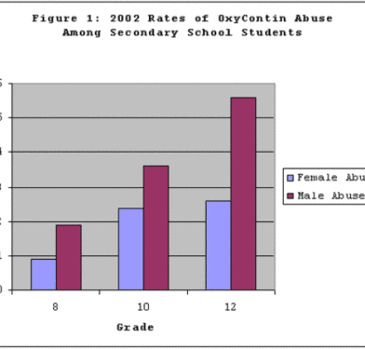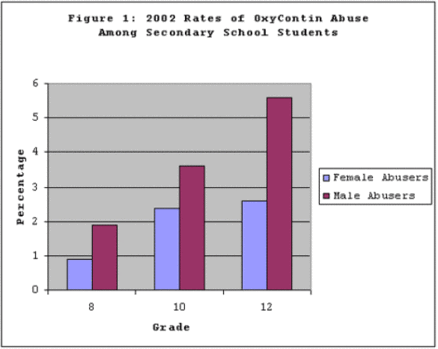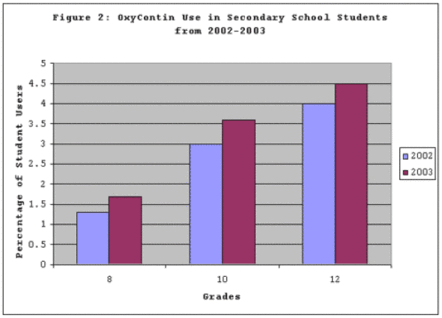Recent research indicates that the misuse of prescription drugs is widespread; during 2003, about one-third of all drugs abused in the U.S. were prescription drugs (Trouble in the medicine chest (I): Rx drug abuse growing, 2003). Many people use prescription drugs for “pharming” (i.e., consuming several prescription pills for nonmedical use). Compared to illegal drugs (e.g., heroin or cocaine), prescription drugs are relatively cheaper and more accessible, yet provide similar euphoria-like effects (Trouble in the medicine chest (I): Rx drug abuse growing, 2003). One prescription drug that has gained notoriety is OxyContin (OC), a synthetic opioid that relieves pain by acting on opioid receptors in the spinal cord, brain, and other tissues (OxyContin diversion, availability, and abuse, 2004). At the recent opening of Massachusetts’ first residential drug recovery treatment center for young girls, a Massachusetts Congressman called for stronger inquiries about the addiction potential of OxyContin (St. Martin, 2005). The assumption that OC presents a burgeoning public health threat prompted the National Drug Intelligence Bulletin to publish an article entitled OxyContin Diversion, Availability, and Abuse (August 2004). This STASH will examine the Bulletin’s report of adolescent OC use.
The Bulletin reviewed numerous epidemiological studies. In this STASH, we focus on the presentation of the Monitoring the Future dataset (MTF) (i.e., the ongoing study of American secondary school students). MTF (2005) surveyed drug abuse in a nationally representative sample of 50,000 students in approximately 420 secondary schools using a multi-stage random sampling procedure. In the first stage, MTF selected particular geographic areas; the next stage selected one or more schools in each area; and the final selection was of classes within selected schools. Personnel from the University of Michigan Survey Research Center and Institutes for Social Research local to the schools administered questionnaires to the students in their usual classrooms during normally held class periods (Design of Monitoring the Future: Purpose and Design, 2005).
Figure. Figure 1 shows that male secondary school students abused OC more than female students during 2002. Interestingly, the percentage of males who abused OC jumped 3.7% from grade 8 to grade 12, while the percentage of females who abused OC only climbed by 1.7%. For both genders, OC abuse increased with grade level. Figure 2 shows that from 2002 to 2003, the percent of students who abused OC increased for all three grades examined. Across grades 8, 10, and 12, the prevalence OC use among students was 8.3% in 2002 and 9.8% in 2003. Adapted from the national drug intelligence bulletin, 2004. Click image to enlarge.
There are a few limitations to the study. Though the MTF study selects a nationally representative secondary school population, it does not account for students who dropped out of school as a result of excessive substance abuse or for other reasons. In addition, the study does not collect data from students whose parents did not permit them to fill out the surveys. (i.e., 10 days before administration of the surveys, advance letters are sent to parents giving them the option of declining their child’s participation). The MTF study also risks a self-reporting bias, that is, students not answering questions completely honestly because they fear they might be disciplined for admitting to drug use or answering positively because they want to sabotage the survey results in a deviant direction.
One theory of the motivation for prescription drug abuse among adolescents is that they ingest these drugs to “die down the pressure” of the extreme competition for top grades, college entrance, and other challenges of higher grades (Trouble in the medicine chest (I): Rx drug abuse growing, 2003). Therefore, it would make sense that as the number and magnitude of demands increase by grade, OC abuse would increase as well. The relatively large number of students who abuse OC prompts us to devote more scientific attention to this issue. First hand accounts of young people’s encounters with this drug provide additional impetus for concern. For example, Katz and Hays (2004), reported the case of a 16-year-old-girl who first tried OC at the age of 14 at the urging of a drug dealer; the dealer subsequently forced her into sexual activity. She continued to abuse OC by raiding her mother’s supply of both OC and Percocet, which had been prescribed for her chronic pain. Ultimately she attempted to commit suicide twice and stole needles from her pediatrician’s office for intravenous OC use. She was eventually admitted to an inpatient unit for treatment. This teenager had no history of substance use prior to trying OC, but rapidly developed a serious addiction during the 6 months after first use (Katz & Hays, 2004). The report published by the National Drug Intelligence Bulletin and the case studies presented by Katz and Hays demonstrate the need for greater awareness of OC abuse and addiction among youth as well as the need to improve our methods and access to treatment for this segment of the population.
What do you think? Please use the comment link below to provide feedback on this article.
References
Design of Monitoring the Future: Purpose and Design. (2005). Retrieved October 21, 2005, from http://www.monitoringthefuture.org/purpose.html
Katz, D. A., & Hays, L. R. (2004). Adolescent OxyContin abuse. Journal of the American Academy of Child & Adolescent Psychiatry, 43(2), 231-234.
OxyContin diversion, availability, and abuse. (2004). Retrieved October 18, 2005, from http://www.usdoj.gov/ndic/pubs10/10550/10550p.pdf
St. Martin, G. (2005, October 25). Southie gets detox beds for girls. The Boston Metro, p. 2.
Trouble in the medicine chest (I): Rx drug abuse growing. (2003). Retrieved October 18, 2005, from http://ncadi.samhsa.gov/govpubs/prevalert/v6/4.aspx






